The Intel Skylake Mobile and Desktop Launch, with Architecture Analysis
by Ian Cutress on September 1, 2015 11:05 PM ESTThe Claims
As with any launch, there are numbers abound from Intel to explain how the performance and experience of Skylake is better than previous designs as well as the competition.
As with Haswell and Broadwell, Intel is implementing a mobile first design with Skylake. As with any processor development structure the primal idea is to focus on one power point as being the most efficient and extend that efficiency window as far in either direction as possible. During IDF, Intel stated that having an efficiency window from 4.5W to 91W is a significant challenge, to which we agree, as well as improving both performance and power consumption over Broadwell at each stage.
Starting at 4.5W, we spoke extensively with parts of Intel at IDF due to our Broadwell-Y coverage. From their perspective Broadwell-Y designs were almost too wide ranging, especially for what is Intel’s premium low-power high performance product, and for the vendors placing it in an ill-defined chassis far away from Intel’s recommended designs gave concern to the final performance and user experience. As a result, Intel’s guidelines to OEMs this generation are tightened so that the designers looking for the cheaper Core M plastic implementations can tune their design to get the best out of it. Intel has been working with a few of these (both entry Core M and premium models) to enact the user experience model.
Overall however, Intel is claiming 40% better graphics performance for Core M with the new Generation 9 (Gen9) implementation, along with battery saving and compatibility with new features such as RealSense. Because Core-M will find its way into products from tablets to 2-in-1s and clamshells, we’ve been told that the Skylake design should hit a home-run against the best-selling tablets in the market, along with an appropriate Windows 10 experience. When we get units in to review, we will see what the score is from our perspective on that one.
For the Skylake-Y to Skylake-U transition (and in part, Skylake-H), Intel is claiming a 60% gain in efficiency over Haswell-U. This means either 60% less active power during media consumption or 60% more CPU performance at the same power (measured by synthetics, specifically SPECint_base_rate2006). The power consumption metrics comes from updates relating to the Gen9 graphics, such as multi-plane overlay and fixed-function decoders, as well as additional power/frequency gating between the unslice and slices. We will cover this later in the review. The GPU itself, due to the new functionality, is claiming 40% better graphics performance for Core M during 3DMark synthetic tests.
While not being launched today, Intel’s march on integrated graphics is also going to continue. With the previous eDRAM parts, Intel took the crown for absolute IGP performance from AMD, albeit being in a completely different price band. With Skylake, the introduction of a 4+4e model means that Intel’s modular graphics design will now extend from GT1 to GT4, where GT4e has 72 execution units with 128MB of eDRAM in tow. This leads to the claim that GT4e is set to match/beat a significant proportion of the graphics market today.
Back in our Skylake-K review, we were perhaps unimpressed with the generational gain in clock-for-clock performance, although improved multi-threading and frequency ranges helped push the out-of-the-box experience. The other side of that performance is the power draw, and because Skylake is another mobile-first processor, the power aspect becomes important down in mobile devices. We will go through some of these developments to improve power consumption in this article.


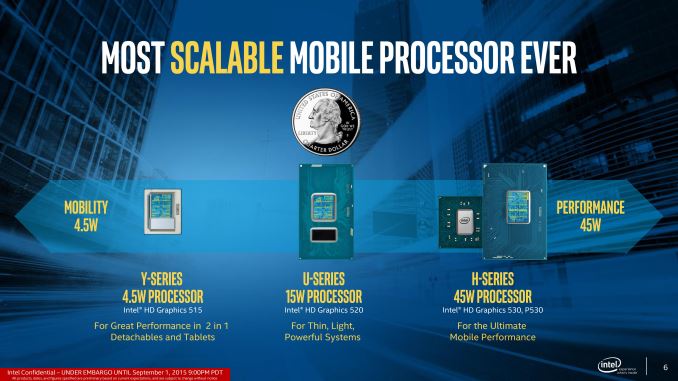
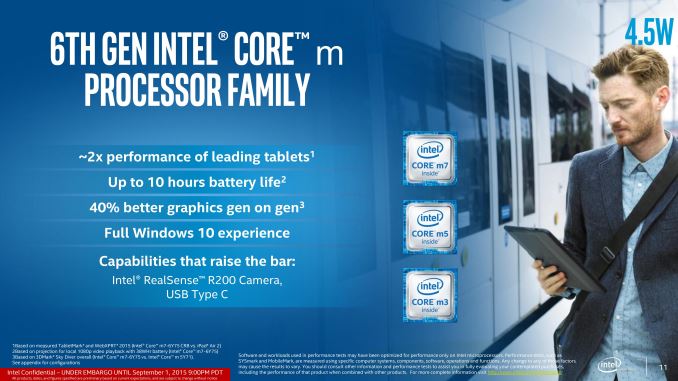
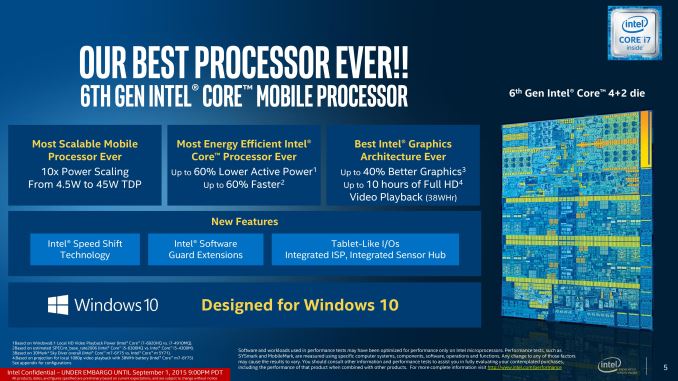
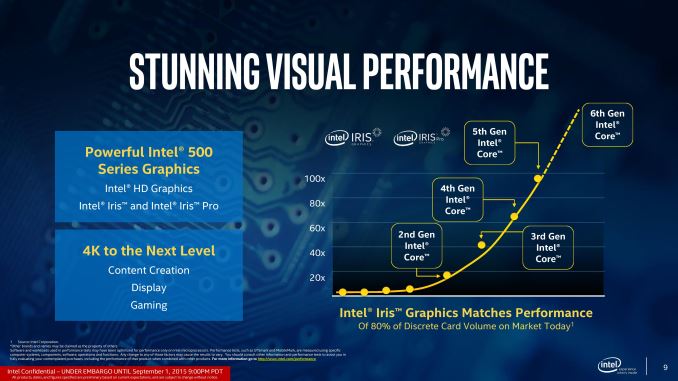
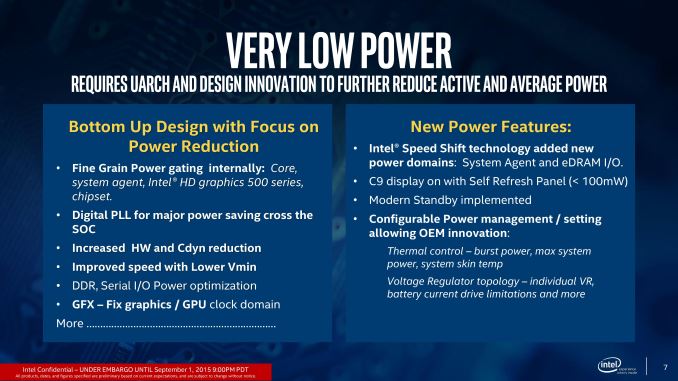








173 Comments
View All Comments
extide - Wednesday, September 2, 2015 - link
Not the number of GPU modules, but the GTx name.For example GT2 has 1 Slice, GT3 has 2 slices, and GT4 has 3 slices.
nandnandnand - Wednesday, September 2, 2015 - link
FIVR: "For Skylake-Y, this also resulted in an increase for the z-height of the processor due to having leveling transistors on the rear of the package."You mean Broadwell-Y, right?
Ryan Smith - Wednesday, September 2, 2015 - link
Correct. Thanks for pointing that out.jay401 - Wednesday, September 2, 2015 - link
What's the ETA for i7-6700 to hit U.S. retail/etail shelves?HideOut - Wednesday, September 2, 2015 - link
A couple of weeks ago. I see them on newegg.com all the time.jay401 - Wednesday, September 2, 2015 - link
Doubtful. You might have seen a 6700K model briefly for a moment before it instantly sold out again, but you haven't seen a 6700 non-K model since their launch just happened (but the SKU isn't even in Amazon or Newegg yet).nandnandnand - Wednesday, September 2, 2015 - link
"This is followed up by either one, two or three slices, where each slide holds three sub-slices of 8 EUs," (page 6)SLIDE = SLICE. deleteme
Ryan Smith - Wednesday, September 2, 2015 - link
MS Word has a terrible fit with slices... Thanks!Le Geek - Wednesday, September 2, 2015 - link
I find it surprising that the reviewer failed to mention anything about the new quad core/quad threaded mobile i5s. To me these are one of the most, if not the most interesting new SKUs.Also it would be nice if these was if there was a specific new article investigating the efficiency gains from Skylake. From the Skylake K review it seemed that the 6700k consumed too much power for the performance improvements it gave. Maybe it was due to the much higher voltages. In any case it would be interesting to see a follow up article.
Cheers.
Le Geek - Wednesday, September 2, 2015 - link
If there was*